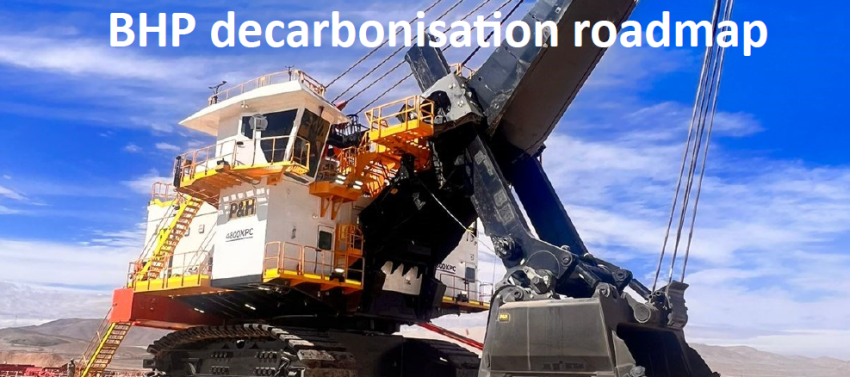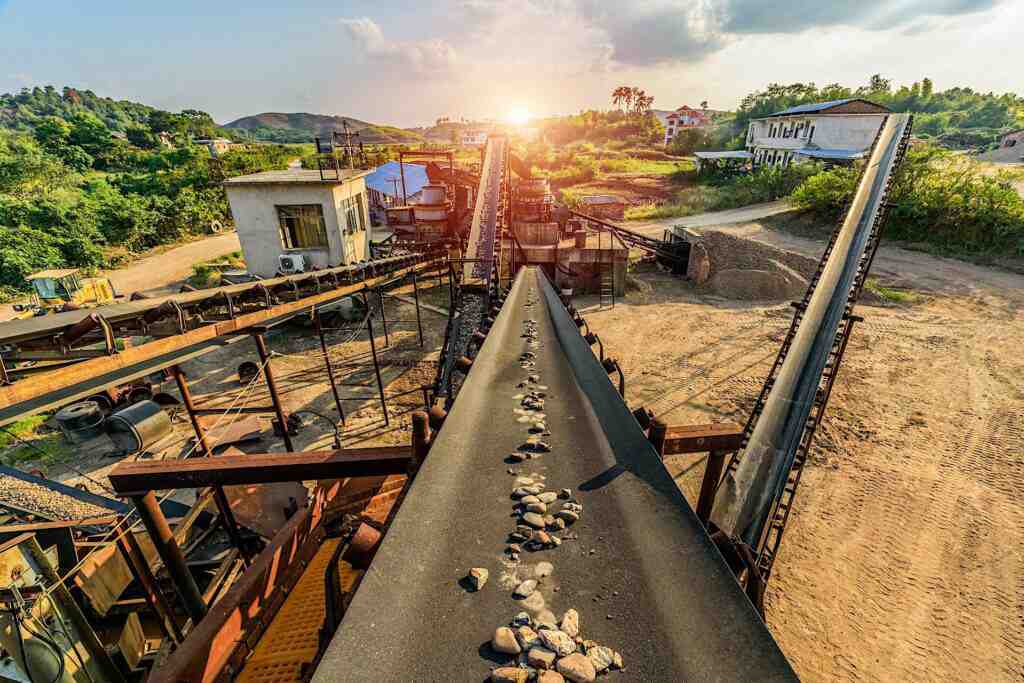
Leading diversified miner BHP has said it will need a “wedge” of offsets to meet its 2050 net zero aspirations. During a special webinar, various company experts provided an update on its decarbonisation plans, including the plan for its haulage fleet, steelmaking business and ocean freight.
The company’s VP Climate, Dr Graham Winkelman, said BHP is on track to deliver its target of at least a 30% reduction in operational GHG emissions in the 2030 financial year from its 2020 baseline. BHP has an aspirational goal to achieve net zero GHG emissions by 2050, and net zero Scope 3 emissions by 2050.
BHPs emissions in 2023 were 32% below the 2020 base-line, after adjusting for recent acquisitions and divestments. This fall was mainly achieved through the use of renewable electricity via power purchase agreements (PPAs), particularly in Chile. Its emissions profile is now weighted towards diesel. “While technology solutions for diesel displacement are emerging, many are not yet mature and available at the scale required,” said Dr Winkelman.
Growth through 2030 is likely to mean emissions will increase over 2023 levels. To counter this, the company plans to deploy additional renewable power projects and further efforts to deliver abatement from the use of diesel and natural gas, and for fugitive methane. However,“...we will be reliant on technology still under development. If technology develops as we believe it can, we expect the first electric truck fleet adoption by 2028, and in 2030, the first of multiple future electric locomotive deployments… While we do not plan for the use of offsetting to meet our 2030 target, we do anticipate the need for some carbon credits to deliver on our net zero goal by 2050,” said Dr Winkelman.
Scope 2
Dan Heal, VP Operational Decarbonisation, spoke about BHP’s plan to reduce Scope 2 emissions, which is focused around the electrification of its mines, and the replacement of its diesel haulage fleet.
The use of PPA has given the company a pathway to a 50% reduction in emissions by 2025, in most of its grid-connected operations. The Escondida and Spence copper mines in Chile have already transitioned to 100% renewable energy. “Our aim is to pursue maximum renewable electricity penetration at all grid-connected operated sites, with an aim of 100% purchased renewable electricity by 2030, where available and commercially viable,” said Heal.
The company’s iron ore operations in the Pilbara in Western Australia are not grid-connected and so it is looking at the installation of solar power. “The Pilbara is remote ...we are working through the best way to introduce large volumes of renewable energy, or other sources of low to zero emissions power, while keeping power running 24/7, 365 days a year. By the end of this decade, we plan to have up to 500MW of wind, solar and battery storage assets available in the Pilbara, backed up by firm power from our highly efficient Yarnima gas fired power station,” said Heal.
Heal said that each year, BHPs global operations use about 1,850 mega litres of diesel in over 1,500 pieces of equipment, about half of this in its truck fleets. “We continue to believe that an electrified mining fleet will be more economic than hydrogen. This is primarily driven by the overall efficiency of an electrified pathway. Some of our core mining equipment is already available in an electrical configuration. For example, Escondida operates electric shovels and has had electric drills for many years,”.
An added challenge is that the electrification of a mobile fleet means operations will demand more power, with diesel displacement increasing the amount of electricity required at some assets by up to four times. “Replacing diesel will require us to develop a whole new operational ecosystem to surround the fleet and every part of the mine will be touched by this change,” said Heal.
Heal stated the pathway to haulage electrification in-cludes the use of trolley-assisted haul trucks, to initially reduce diesel consumption, but to then be an enabler for future rollout battery-electric haul trucks.
“We will approach trolley assist in three stages: Firstly, we will be progressively replacing our current mechanical drive haul trucks with electric drive ones. Then, we will implement trolley assist. We will soon begin testing diesel-electric trolley assist at Escondida, followed by Spence, with implementation of the first stage expected in 2028 and 2029. Next decade, we will expand the trolley infrastructure to assist a transition from diesel-electric to battery-electric haul trucks. This will allow the energy to go straight to charging the truck’s batteries while operating,” .
As July got underway, BHP had filed an environmental declaration to install a $250 million trolley system at Escondida. This includes the construction of a new electricity substation and transmission lines. Heal stated that the electrification of haulage brings new operating challenges, including how the company plans and operates its mines, how and when it charges equipment, and how it manages power supply and demand.
Scope 3
BHPs Scope 3 emissions are mainly generated from the steel industry to which it supplies iron ore and metallurgical coal, and the ocean freight of shipping bulk materials around the globe. Steelmaking emissions represent about 85% of the company’s reported Scope 3 emissions.
To address these, the company is seeking to support the development and adoption of GHG emission abatement technologies in steelmaking, enhance the quality of the iron ore and steelmaking coal produced, support the development and adoption of GHG emission abatement technologies in shipping, and encourage its suppliers to pursue net zero GHG emissions.
Dr Nigel Tame, Head of Decarbonisation Partnerships said that achieving a net zero world requires near zero emission steelmaking technology, although no technologies for ore-based steelmaking are currently feasible for widespread adoption. Since its steelmaking assistance programme began in 2020, BHP has budgeted more than $200 million to research and has partnerships with steelmakers who represent about 20% of reported global steelmaking production.
Carbon capture is being pursued to decarbonise blast furnace steel production, with nine out of 10 of the largest steel producers including this in their net zero roadmaps. For the DRI-ESF/EAF process, BHP seeks to optimise the performance of its iron ores for direct reduced iron (DRI), such as pelletising. “To optimise [electric smelting furnace], we need a deeper understanding of how DRI feed materials, based on our Pilbara ores, interact with ESF operational parameters to produce iron at the quality and productivity needed for downstream steel,” said Dr Tame.
BHP is one of the world’s largest dry bulk charterers, and it seeks to support an emissions intensity reduction of 40% in BHP chartered shipping of our products by 2030 and net zero emissions by 2050. Ashima Taneja, Head of Maritime Safety, Sustainability & Technical said various initiatives to achieve this include consolidating parcel sizes to use larger and more efficient vessels, premium hull coatings and wind-assisted propulsion, promoting the uptake of low to zero GHG emission fuels, such as ammonia, and making better chartering choices by ensuring completeness and accuracy of carbon accounting.
“We see significant potential in the trial and adoption of low to zero-emission alternatives such as ammonia. It is the only alternative with no carbon in its composition, it is a zero emissions fuel and has pricing and supply dynamics that enable a future potential use in maritime.
We have launched an expression of interest to help develop the ammonia value chain along an Iron Ore Green Corridor,” said Taneja.
The Iron Ore Green Corridor would be specific shipping routes where the economics, infrastructure and logistics of low to zero emissions shipping are more feasible and rapid deployment can be supported by targeted policy and industry action. “Our intent is to deploy ammonia dual-fueled vessels on our iron ore trade route between Western Australia and China ports before 2030,” said Taneja.
MORE FROM SKARN

About Us
Skarn Associates is the market leader in quantifying and benchmarking asset-level greenhouse gas emissions, energy intensity, and water use across the mining sector.
